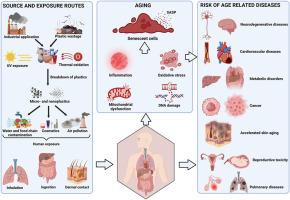Nanoplastics: An emerging environmental concern in age-related diseases
IF 7.3
2区 环境科学与生态学
Q1 ENVIRONMENTAL SCIENCES
引用次数: 0
Abstract
The global demand for plastics has increased in recent years, with annual production exceeding 400 million tons. Despite their versatility and economic advantages, plastics pose severe environmental challenges due to inadequate waste management, with only 9 % being recycled. The rest accumulate in the environment, leading to widespread plastic pollution and the emergence of nanoplastics (NPs), plastic particles smaller than 0.1 μm. Their persistence in ecosystems, air, and water sources has raised significant ecological and health concerns. Beyond environmental concerns, NPs have been found in human tissues, with growing evidence linking them to adverse biological effects. Of particular concern is their role in aging and age-related diseases. Their ability to disrupt molecular pathways involved in DNA damage, mitochondrial function, and immune responses further implicates them in premature aging. Moreover, the interaction of NPs with cellular machinery can alter critical signaling pathways, such as p53 and p16INK4a/Rb, which regulate cell cycle progression and genomic integrity. Dysregulation of these pathways by NPs may drive cellular senescence, an irreversible growth arrest state contributing to tissue dysfunction and age-related pathologies. This review specifically highlights the mechanistic links between NPs exposure, cellular senescence, and biological aging, offering a novel and timely perspective on how NPs may contribute to age-related pathologies. It aims to examine recent researches on NPs in relation to senescence and aging, providing insights into their mechanistic impact at cellular and systemic levels. By analyzing emerging evidence on their role in senescence and aging, this study highlights potential health risks and underscores the urgent need for further investigations and regulatory measures to mitigate their long-term consequences.


纳米塑料:与年龄相关疾病的新兴环境问题
近年来,全球对塑料的需求不断增加,年产量超过4亿吨。尽管塑料具有多功能性和经济优势,但由于废物管理不足,塑料构成了严峻的环境挑战,只有9%的塑料被回收利用。其余的在环境中积累,导致广泛的塑料污染和纳米塑料(NPs)的出现,纳米塑料是小于0.1 μm的塑料颗粒。它们在生态系统、空气和水源中的持续存在引起了重大的生态和健康问题。除了环境问题,人体组织中也发现了NPs,越来越多的证据表明它们与不利的生物效应有关。特别令人关注的是它们在衰老和与年龄有关的疾病中的作用。它们破坏涉及DNA损伤、线粒体功能和免疫反应的分子通路的能力进一步暗示它们与早衰有关。此外,NPs与细胞机制的相互作用可以改变关键的信号通路,如p53和p16INK4a/Rb,这些信号通路调节细胞周期进程和基因组完整性。NPs对这些通路的失调可能会导致细胞衰老,这是一种不可逆的生长停滞状态,导致组织功能障碍和与年龄相关的病理。这篇综述特别强调了NPs暴露、细胞衰老和生物衰老之间的机制联系,为NPs如何促进年龄相关病理提供了一个新颖而及时的视角。它的目的是检查有关NPs的衰老和衰老的最新研究,提供洞察其在细胞和系统水平的机制影响。通过分析其在衰老和衰老中作用的新证据,本研究强调了潜在的健康风险,并强调了进一步调查和监管措施以减轻其长期后果的迫切需要。
本文章由计算机程序翻译,如有差异,请以英文原文为准。
求助全文
约1分钟内获得全文
求助全文
来源期刊

Environmental Pollution
环境科学-环境科学
CiteScore
16.00
自引率
6.70%
发文量
2082
审稿时长
2.9 months
期刊介绍:
Environmental Pollution is an international peer-reviewed journal that publishes high-quality research papers and review articles covering all aspects of environmental pollution and its impacts on ecosystems and human health.
Subject areas include, but are not limited to:
• Sources and occurrences of pollutants that are clearly defined and measured in environmental compartments, food and food-related items, and human bodies;
• Interlinks between contaminant exposure and biological, ecological, and human health effects, including those of climate change;
• Contaminants of emerging concerns (including but not limited to antibiotic resistant microorganisms or genes, microplastics/nanoplastics, electronic wastes, light, and noise) and/or their biological, ecological, or human health effects;
• Laboratory and field studies on the remediation/mitigation of environmental pollution via new techniques and with clear links to biological, ecological, or human health effects;
• Modeling of pollution processes, patterns, or trends that is of clear environmental and/or human health interest;
• New techniques that measure and examine environmental occurrences, transport, behavior, and effects of pollutants within the environment or the laboratory, provided that they can be clearly used to address problems within regional or global environmental compartments.
 求助内容:
求助内容: 应助结果提醒方式:
应助结果提醒方式:


